
Languedoc wine
Encyclopedia
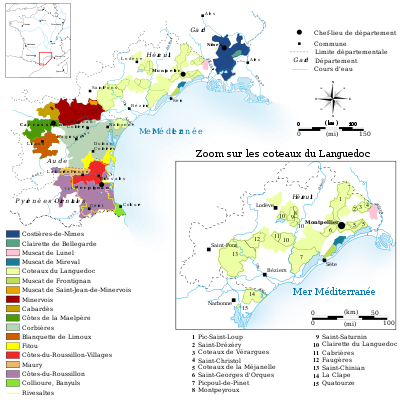
Vin de pays
Vin de pays is a French term meaning "country wine". Vins de pays are a step in the French wine classification which is above the table wine classification, but below the VDQS and Appellation d'origine contrôlée classifications...
labeled Vin de Pays d'Oc, is produced in southern France
France
The French Republic , The French Republic , The French Republic , (commonly known as France , is a unitary semi-presidential republic in Western Europe with several overseas territories and islands located on other continents and in the Indian, Pacific, and Atlantic oceans. Metropolitan France...
. While "Languedoc" can refer to a specific historic region
Languedoc
Languedoc is a former province of France, now continued in the modern-day régions of Languedoc-Roussillon and Midi-Pyrénées in the south of France, and whose capital city was Toulouse, now in Midi-Pyrénées. It had an area of approximately 42,700 km² .-Geographical Extent:The traditional...
of France and Northern Catalonia
Northern Catalonia
Northern Catalonia is a term that is sometimes used, particularly in Catalan writings, to refer to the territory ceded to France by Spain through the signing of the Treaty of the Pyrenees in 1659...
, usage since the 20th century (especially in the context of wine) has primarily referred to the northern part of the Languedoc-Roussillon
Languedoc-Roussillon
Languedoc-Roussillon is one of the 27 regions of France. It comprises five departments, and borders the other French regions of Provence-Alpes-Côte d'Azur, Rhône-Alpes, Auvergne, Midi-Pyrénées on the one side, and Spain, Andorra and the Mediterranean sea on the other side.-Geography:The region is...
région
Region
Region is most commonly found as a term used in terrestrial and astrophysics sciences also an area, notably among the different sub-disciplines of geography, studied by regional geographers. Regions consist of subregions that contain clusters of like areas that are distinctive by their uniformity...
of France, an area which spans the Mediterranean
Mediterranean Sea
The Mediterranean Sea is a sea connected to the Atlantic Ocean surrounded by the Mediterranean region and almost completely enclosed by land: on the north by Anatolia and Europe, on the south by North Africa, and on the east by the Levant...
coastline from the French border with Spain
Spain
Spain , officially the Kingdom of Spain languages]] under the European Charter for Regional or Minority Languages. In each of these, Spain's official name is as follows:;;;;;;), is a country and member state of the European Union located in southwestern Europe on the Iberian Peninsula...
to the region of Provence
Provence
Provence ; Provençal: Provença in classical norm or Prouvènço in Mistralian norm) is a region of south eastern France on the Mediterranean adjacent to Italy. It is part of the administrative région of Provence-Alpes-Côte d'Azur...
. The area has around 700000 acres (2,832.8 km²) under vines and is the single biggest wine-producing region in the world, being responsible for more than a third of France's total wine production. As recently as 2001, the region produced more wine than the entire United States
American wine
American wine has been produced for over 300 years. Today, wine production is undertaken in all fifty states, with California producing 89 percent of all US wine...
.
History
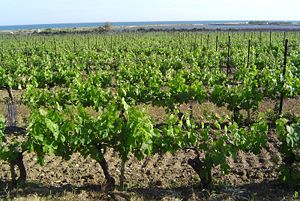
Narbonne
Narbonne is a commune in southern France in the Languedoc-Roussillon region. It lies from Paris in the Aude department, of which it is a sub-prefecture. Once a prosperous port, it is now located about from the shores of the Mediterranean Sea...
by the early Greeks
Greeks
The Greeks, also known as the Hellenes , are a nation and ethnic group native to Greece, Cyprus and neighboring regions. They also form a significant diaspora, with Greek communities established around the world....
in the fifth century BC. Along with parts of Provence
Provence
Provence ; Provençal: Provença in classical norm or Prouvènço in Mistralian norm) is a region of south eastern France on the Mediterranean adjacent to Italy. It is part of the administrative région of Provence-Alpes-Côte d'Azur...
, these are the oldest planted vineyards in France. The region of Languedoc has belonged to France since the thirteenth century and the Roussillon
Roussillon
Roussillon is one of the historical counties of the former Principality of Catalonia, corresponding roughly to the present-day southern French département of Pyrénées-Orientales...
was acquired from Spain
Spain
Spain , officially the Kingdom of Spain languages]] under the European Charter for Regional or Minority Languages. In each of these, Spain's official name is as follows:;;;;;;), is a country and member state of the European Union located in southwestern Europe on the Iberian Peninsula...
in the mid-seventeenth century. The two regions were joined as one administrative region in the late 1980s.
From the 4th century through the 18th and early 19th centuries, the Languedoc had a reputation for producing high quality wine. In Paris
Paris
Paris is the capital and largest city in France, situated on the river Seine, in northern France, at the heart of the Île-de-France region...
during the 14th century, wines from the St. Chinian area were prescribed in hospitals for their "healing powers". During the advent of the Industrial Age
Industrial Age
Industrial Age may refer to:*Industrialisation*The Industrial Revolution...
in the late 19th century, production shifted towards mass produced le gros rouge — cheap red wine that could satisfy the growing work force. The use of highly prolific grape varieties produced high yields and thin wines, which were normally blended with red wine from Algeria
Algeria
Algeria , officially the People's Democratic Republic of Algeria , also formally referred to as the Democratic and Popular Republic of Algeria, is a country in the Maghreb region of Northwest Africa with Algiers as its capital.In terms of land area, it is the largest country in Africa and the Arab...
to give them more body.
The phylloxera
Phylloxera
Grape phylloxera ; originally described in France as Phylloxera vastatrix; equated to the previously described Daktulosphaira vitifoliae, Phylloxera vitifoliae; commonly just called phylloxera is a pest of commercial grapevines worldwide, originally native to eastern North America...
epidemic in the 19th century severely affected the Languedoc wine industry, killing off many of the higher quality Vitis vinifera
Vitis vinifera
Vitis vinifera is a species of Vitis, native to the Mediterranean region, central Europe, and southwestern Asia, from Morocco and Portugal north to southern Germany and east to northern Iran....
that were susceptible to the louse. American rootstock
Rootstock
A rootstock is a plant, and sometimes just the stump, which already has an established, healthy root system, used for grafting a cutting or budding from another plant. The tree part being grafted onto the rootstock is usually called the scion...
that was naturally resistant to phylloxera did not take well to the limestone
Limestone
Limestone is a sedimentary rock composed largely of the minerals calcite and aragonite, which are different crystal forms of calcium carbonate . Many limestones are composed from skeletal fragments of marine organisms such as coral or foraminifera....
soil on the hillside. In place of these vines, acres of the lower quality Aramon
Aramon (grape)
Aramon or Aramon Noir is a variety of red wine grape grown primarily in Languedoc-Roussillon in southern France. Between the late 19th century and the 1960s, it was France's most grown grape variety, but plantings of Aramon have been in continuous decline since the mid-20th century...
, Alicante Bouschet
Alicante Bouschet
Alicante Bouschet or Alicante Henri Bouschet is a wine grape variety that has been widely cultivated since 1866. It is a cross of Petit Bouschet and Grenache. Alicante is a teinturier, a grape with red flesh. It is one of the few teinturier grapes that belong to the Vitis vinifera species...
and Carignan were planted.
During both World Wars the Languedoc was responsible for providing the daily wine rations given to French soldiers. In 1962, Algeria gained its independence from France, bringing about an end to the blending of the stronger Algerian red wine to mask the thin le gros rouge. This event, coupled with French consumers moving away from cheap red wines in the 1970s, has contributed to several decades of surplus wine production at the in France, with Languedoc as the largest contributor to the European "wine lake
Wine lake
The wine lake refers to the continuing supply surplus of wine produced in the European Union. A major contributor to that glut is the Languedoc-Roussillon, which produces over one-third of the grapes grown in France. In 2007 it was reported that for the previous several vintages, European...
" and recurring European Union
European Union
The European Union is an economic and political union of 27 independent member states which are located primarily in Europe. The EU traces its origins from the European Coal and Steel Community and the European Economic Community , formed by six countries in 1958...
subsidies aimed at reducing production. These developments prompted many Languedoc producers to start refocusing on higher quality, but has also led to many local and regional protests, including violent ones from the infamous Comité Régional d'Action Viticole
Comité Régional d'Action Viticole
Comité régional d'action viticole , or sometimes Comité d'action viticole is a French group of radical wine producers...
(CRAV).
Despite the general reputation as a mass producer and a consensus that the region is in the midst of an economic crisis, parts of the Languedoc wine industry are experiencing commercial success due to outside investment and an increased focus on quality. Sales have been improved by many vineyards that concentrate on creating a good brand name rather than relying on the sometimes infamous regional designations. Some vineyards have adopted the youngest batch of AOC
Appellation d'Origine Contrôlée
Appellation d’origine contrôlée , which translates as "controlled designation of origin", is the French certification granted to certain French geographical indications for wines, cheeses, butters, and other agricultural products, all under the auspices of the government bureau Institut National...
classifications developed in the late 1990s, while other vineyards eschew designated blends entirely and are instead shifting toward bottling single varietal wines, a practice increasingly demanded by consumers in the large New World wine
New World wine
New World wines are those wines produced outside the traditional wine-growing areas of Europe, in particular from Argentina, Australia, Canada, Chile, New Zealand, South Africa and the United States.-Early wines in the Americas:...
market.

Climate and geography
The Languedoc-Roussillon region shares many terrain and climate characteristics with the neighboring regions of Southern RhoneRhône (wine region)
The Rhône wine region in Southern France is situated in the Rhône river valley and produces numerous wines under various Appellation d'origine contrôlée designations...
and Provence
Provence
Provence ; Provençal: Provença in classical norm or Prouvènço in Mistralian norm) is a region of south eastern France on the Mediterranean adjacent to Italy. It is part of the administrative région of Provence-Alpes-Côte d'Azur...
. The region stretches 150 miles (241.4 km) from the Banyuls AOC
Banyuls AOC
Banyuls is a French appellation d'origine contrôlée for a fortified apéritif or dessert wine made from old vines cultivated in terraces on the slopes of the Catalan Pyrenees in the Roussillon county of France, bordering, to the south, the Empordà wine region in Catalonia in Spain.The AOC...
at the Spanish
Spain
Spain , officially the Kingdom of Spain languages]] under the European Charter for Regional or Minority Languages. In each of these, Spain's official name is as follows:;;;;;;), is a country and member state of the European Union located in southwestern Europe on the Iberian Peninsula...
border and Pyrenees
Pyrenees
The Pyrenees is a range of mountains in southwest Europe that forms a natural border between France and Spain...
in the west, along the coast of the Mediterranean Sea
Mediterranean Sea
The Mediterranean Sea is a sea connected to the Atlantic Ocean surrounded by the Mediterranean region and almost completely enclosed by land: on the north by Anatolia and Europe, on the south by North Africa, and on the east by the Levant...
to the Rhone River
Rhône River
The Rhone is one of the major rivers of Europe, rising in Switzerland and running from there through southeastern France. At Arles, near its mouth on the Mediterranean Sea, the river divides into two branches, known as the Great Rhone and the Little Rhone...
and Provence in the east. The northern boundaries of the region sit on the Massif Central
Massif Central
The Massif Central is an elevated region in south-central France, consisting of mountains and plateaux....
with the Cévennes
Cévennes
The Cévennes are a range of mountains in south-central France, covering parts of the départements of Gard, Lozère, Ardèche, and Haute-Loire.The word Cévennes comes from the Gaulish Cebenna, which was Latinized by Julius Caesar to Cevenna...
mountain ranges and valleys dominating the area. Many vineyards are located along the Hérault River
Hérault River
The Hérault is a river of southern France. Its length is . Its source is in the Cévennes mountains. It reaches the Mediterranean Sea near Agde...
.
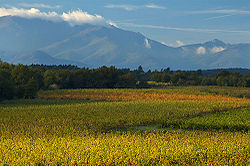
Appellation d'Origine Contrôlée
Appellation d’origine contrôlée , which translates as "controlled designation of origin", is the French certification granted to certain French geographical indications for wines, cheeses, butters, and other agricultural products, all under the auspices of the government bureau Institut National...
and European Union
European Union
The European Union is an economic and political union of 27 independent member states which are located primarily in Europe. The EU traces its origins from the European Coal and Steel Community and the European Economic Community , formed by six countries in 1958...
regulation prohibiting the use of irrigation. In December 2006, the French government responded to global warming
Global warming
Global warming refers to the rising average temperature of Earth's atmosphere and oceans and its projected continuation. In the last 100 years, Earth's average surface temperature increased by about with about two thirds of the increase occurring over just the last three decades...
concerns and relaxed some of the irrigation regulations.
In 1999 severe weather
Severe weather
Severe weather phenomena are weather conditions that are hazardous to human life and property.- Examples Include :Severe weather can occur under a variety of situations, but three characteristics are generally needed: a temperature or moisture boundary, moisture, and , instability in the...
had damaging affects on the wine producing industry, including hail
Hail
Hail is a form of solid precipitation. It consists of balls or irregular lumps of ice, each of which is referred to as a hail stone. Hail stones on Earth consist mostly of water ice and measure between and in diameter, with the larger stones coming from severe thunderstorms...
storms in May that affected Roussillon and a rain surge in mid November that saw a year's worth of rain fall in 36 hours in the areas of Corbières
Corbières AOC
Corbières is an Appellation d'origine contrôlée for wine in the Languedoc-Roussillon, and it is this region's largest AOC, responsible for 46 per cent of the region's AOC wine production in 2005. Red wine dominates the production in Corbières with almost 95 per cent, with 3.5 per cent rosé wine...
and Minervois in the western Languedoc.
The composition of soil in the Languedoc varies from the chalk, limestone and gravel based soils inland to more alluvial soils near the coast. Some of the more highly-rated vineyards are laid on top of ancient riverbed stones similar to those of Châteauneuf-du-Pape
Châteauneuf-du-Pape
Châteauneuf-du-Pape is a commune in the Vaucluse department in the Provence-Alpes-Côte d'Azur region in southeastern France.-History:Châteauneuf-du-Pape is firmly entwined with papal history. In 1308, Pope Clement V, former Archbishop of Bordeaux, relocated the papacy to the city of Avignon...
.
Appellations
The five best known appellations in the Languedoc include Coteaux du Languedoc, Corbières AOCCorbières AOC
Corbières is an Appellation d'origine contrôlée for wine in the Languedoc-Roussillon, and it is this region's largest AOC, responsible for 46 per cent of the region's AOC wine production in 2005. Red wine dominates the production in Corbières with almost 95 per cent, with 3.5 per cent rosé wine...
, Faugères
Faugères AOC
Faugères is an Appellation d'origine contrôlée in the Languedoc-Roussillon wine region in France and is named after Faugères. It is also known as Coteaux-du-Languedoc Faugères and lies 20 km northwest of Béziers, on the hills of Hérault...
, Minervois AOC, and Saint-Chinian AOC
Saint-Chinian AOC
Saint-Chinian is an Appellation d'origine contrôlée in the Languedoc-Roussillon wine region in France and is named after Saint-Chinian.-Prehistoric and antiquity:...
s. The vast majority of Languedoc wines are produced by wine cooperatives which number more than 500. However, the appellation system in the region is undergoing considerable changes with both new appellations being created and existing ones changing. One recent change is that the Coteaux du Languedoc has changed name to Languedoc and been extended to include also the Roussillon.
Within the larger Coteaux du Languedoc appellations are several sub-districts with distinct wine styles of their own. Some of these sub-districts have pending AOC applications to become appellations in their own right and some have been granted sub-appellations to the umbrella appellation Coteaux du Languedoc. These include the Quatourze, La Clape, Montpeyroux
Montpeyroux
Montpeyroux may refer to the following places in France:* Montpeyroux, Aveyron, a commune of the Aveyron département* Montpeyroux, Dordogne, a commune of the Dordogne département* Montpeyroux, Hérault, a commune of the Hérault département...
, St. Saturnin, Picpoul de Pinet, Terrasses du Larzac
Terrasses du Larzac
Terrasses du Larzac is an Appellation d’origine contrôlée within the Côteaux du Languedoc in Southern France created in 2005 for red wines made from Syrah, Grenache and Mourvèdre grapes, with the acceptable additions of Cinsaut and Carignan, and grown in some of the highest vineyards of the...
and Pic St.-Loup.
The boundary of the eastern Languedoc with the Southern Rhône Valley wine region was moved slightly in 2004, with the result that Costières de Nîmes AOC
Costières de Nîmes AOC
Costières de Nîmes is an Appellation d'Origine Contrôlée for wines that are produced in an area between the ancient city of Nîmes and the western Rhône delta, in the French department of the Gard...
is now a Rhône appellation rather than a Languedoc one. In that year, INAO
Institut National des Appellations d'Origine
The Institut National des Appellations d'Origine is the French organization charged with regulating French agricultural products with Protected Designations of Origin . Controlled by the French government, it forms part of the Ministry of Agriculture...
moved the responsibility for oversight of this appellation's wine to the regional committee of the Rhône valley. Local producers of Côtes du Rhône-styled wines made from Syrah and Grenache
Grenache
Grenache is one of the most widely planted red wine grape varieties in the world. It ripens late, so it needs hot, dry conditions such as those found in Spain, the south of France, and California's San Joaquin Valley. It is generally spicy, berry-flavored and soft on the palate with a relatively...
lobbied for this change since the local winemaking traditions did not coincide with administrative borders, and presumably due to the greater prestige of Rhône wines in the marketplace. Such changes of borders between wine regions are very rare, so out of habit, Costières de Nîmes remains listed as a Languedoc wine in many publications.
Grapes
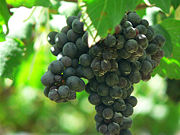
Merlot
Merlot is a darkly blue-coloured wine grape, that is used as both a blending grape and for varietal wines. The name Merlot is thought to derive from the Old French word for young blackbird, merlot, a diminutive of merle, the blackbird , probably from the color of the grape. Merlot-based wines...
, Cabernet Sauvignon
Cabernet Sauvignon
Cabernet Sauvignon is one of the world's most widely recognized red wine grape varieties. It is grown in nearly every major wine producing country among a diverse spectrum of climates from Canada's Okanagan Valley to Lebanon's Beqaa Valley...
, Sauvignon Blanc
Sauvignon blanc
Sauvignon Blanc is a green-skinned grape variety which originates from the Bordeaux region of France. The grape most likely gets its name from the French word sauvage and blanc due to its early origins as an indigenous grape in South West France., a possible descendant of savagnin...
and Chardonnay
Chardonnay
Chardonnay is a green-skinned grape variety used to make white wine. It is originated from the Burgundy wine region of eastern France but is now grown wherever wine is produced, from England to New Zealand...
. The traditional Rhône grapes of Mourvedre
Mourvèdre
Mourvèdre , Mataró or Monastrell is wine grape variety used to make both strong, dark red wines and rosés. It is an international variety grown in many regions around the world....
, Grenache, Syrah and Viognier
Viognier
Viognier is a white wine grape. It is the only permitted grape for the French wine Condrieu in the Rhone valley.-History:The origin of the Viognier grape is unknown. Viognier is presumed to be an ancient grape, possibly originating in Dalmatia and then brought to Rhône by the Romans. One legend...
are also prominent.
Chardonnay is a major white grape, used in the Vin de Pays d'Oc and the sparkling Crémant de Limoux. Others include Chenin Blanc
Chenin Blanc
Chenin blanc , is a white wine grape variety from the Loire valley of France. Its high acidity means it can be used to make everything from sparkling wines to well-balanced dessert wines, although it can produce very bland, neutral wines if the vine's natural vigor is not controlled...
and Mauzac
Mauzac (grape)
Mauzac or Mauzac Blanc a white variety of grape used for wine, of the species Vitis vinifera. It is mainly grown in the Gaillac and Limoux regions in the southwest of France. Total French plantations of Mauzac stood at in the year 2000....
, which is also the principal grape in the sparkling Blanquette de Limoux. The sweet fortified wine
Fortified wine
Fortified wine is wine to which a distilled beverage has been added. Fortified wine is distinguished from spirits made from wine in that spirits are produced by means of distillation, while fortified wine is simply wine that has had a spirit added to it...
s of the Muscat de Frontignan and Muscat de St-Jean Minervois regions are made with the Muscat Blanc à Petits Grains
Muscat Blanc à Petits Grains
Muscat Blanc à Petits Grains is a white wine grape that is a member of the Muscat family of Vitis vinifera. Its name comes from its characteristic small berry size and tight clusters...
grapes. In the Muscat de Rivesaltes AOC
Muscat de Rivesaltes AOC
Muscat de Rivesaltes is an Appellation d'Origine Contrôlée for fortified wines made in the Roussillon wine region of France. They are similar to Rivesaltes AOC wines, except for the grape varieties used...
, fortified wines are made from Muscat of Alexandria
Muscat of Alexandria
Muscat of Alexandria is a white wine grape that is a member of the Muscat family of Vitis vinifera. It is considered an "ancient vine", and wine experts believe it is one of the oldest genetically unmodified vines still in existence...
grapes.
Among the reds, Grenache, Syrah, Carignan, Cinsault and Mourvedre
Mourvèdre
Mourvèdre , Mataró or Monastrell is wine grape variety used to make both strong, dark red wines and rosés. It is an international variety grown in many regions around the world....
are major grapes of the Corbières, Faugères
Faugères AOC
Faugères is an Appellation d'origine contrôlée in the Languedoc-Roussillon wine region in France and is named after Faugères. It is also known as Coteaux-du-Languedoc Faugères and lies 20 km northwest of Béziers, on the hills of Hérault...
, Fitou, and Minervois AOCs. Cinsault is also commonly used in rosé
Rosé
A rosé is a type of wine that has some of the color typical of a red wine, but only enough to turn it pink. The pink color can range from a pale orange to a vivid near-purple, depending on the grapes and wine making techniques.- Production techniques :There are three major ways to produce rosé...
production along with Lladoner Pelut, Picpoul Noir, Terret Noir
Terret Noir
Terret Noir is a dark-skinned wine grape grown primarily in the Rhône valley region of France. It is a permitted blending grape for Châteauneuf-du-Pape. Like the related Terret Gris and Terret Blanc, the vine tends to bud late and grow vigorously. Terret Noir produces a light color wine that is...
and Grenache. Grenache is also the main grape used in the fortified wines of the Banyuls
Banyuls AOC
Banyuls is a French appellation d'origine contrôlée for a fortified apéritif or dessert wine made from old vines cultivated in terraces on the slopes of the Catalan Pyrenees in the Roussillon county of France, bordering, to the south, the Empordà wine region in Catalonia in Spain.The AOC...
and Rivesaltes region. Some of the oldest vines in France are Carignan grapes. Winemakers often use carbonic maceration
Carbonic maceration
Carbonic maceration is a winemaking technique, often associated with the French wine region of Beaujolais, in which whole grapes are fermented in a carbon dioxide rich environment prior to crushing. Conventional alcoholic fermentation involves crushing the grapes to free the juice and pulp from the...
to soften the tannins.
Other varieties that can be found include Roussanne
Roussanne
Roussanne is a white wine grape grown originally in the Rhône wine region in France, where it is often blended with Marsanne. It is the only other white variety, besides Marsanne, allowed in the northern Rhône appellations of Crozes-Hermitage AOC, Hermitage AOC and Saint-Joseph AOC...
, Marsanne, Vermentino
Vermentino
Vermentino is a late-ripening white grape variety, primarily found in Italian wine. It is widely planted in Sardinia, in Liguria primarily under the name Pigato, to some extent in Corsica, in Piedmont under the name Favorita, and in increasing amounts in Languedoc-Roussillon. The leaves are dark...
, Bourboulenc
Bourboulenc
Bourboulenc is a white wine grape variety primarily grown in southern France. The variety is found in the regions Southern Rhône, Provence and Languedoc....
, Clairette
Clairette
-People:*Clairette , a French-Canadian actress and singer-Wines:*Clairette de Die AOC, a French sparkling wine appellation*Clairette blanche, a white grape variety* Clairette Ronde, synonym for the grape variety Trebbiano...
, Grenache Blanc
Grenache Blanc
Grenache blanc is a variety of white wine grape that is related to the red grape Grenache. It is mostly found in Rhône wine blends and in northeast Spain. Its wines are characterized by high alcohol and low acidity, with citrus and or herbaceous notes. Its vigor can lead to overproduction and...
, Grenache gris, Picpoul, Maccabéo and Rolle
Rolle
Rolle is a municipality in the Canton of Vaud in Switzerland. It was the seat of the district of Rolle until 2006, when it became part of the district of Nyon. It is located on the northwestern shore of Lake Geneva between Nyon and Lausanne...
.
Wines and taxonomy
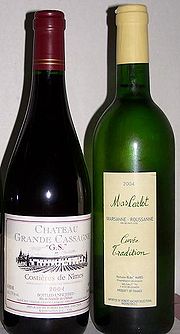
The majority of wine produced in the Languedoc are labeled vin ordinaire. There is also sizable production of Vins Doux Naturels.
Vins de Pays
The introduction of the vins de pays for example Vin de pays d'Oc, Vin de pays d'Aude, Vin de pays de l'Hérault, Vin de Pays du Gard is a classification produced under less stringent regulations than those of an AOC have opened up the Languedoc wine industry to the labeling of varietal wines and the blending of international varieties such as Cabernet Sauvignon, Merlot, Syrah and Chardonnay. Winemakers such as Guy Anderson, Thierry BoudinaudThierry Boudinaud
Thierry Boudinaud is a French winemaker. He partnered with British winemaker Guy Anderson to produce and distribute FAT bastard wine, which is labeled by the variety of grape from which it is made.-References:...
and E. & J. Gallo Winery capitalized on this new horizon, producing wines like FAT bastard
FAT bastard
FAT bastard is a French wine produced and distributed by a British and French partnership. FAT bastard is a fast growing brand, recently selling over 400,000 cases per year in the United States alone, shortly after its introduction. BusinessWeek has called FAT Bastard a "marketing phenomenon"...
and Red Bicyclette
Red Bicyclette
Red Bicyclette is a French wine produced by the Sieur d'Arques cooperative and distributed in the USA by the E. & J. Gallo Winery. Its distinctive label appeals to consumers who prefer branded wines, labelled with the variety of grape from which they are made, rather than by the exact location...
.
Vins Doux Naturels
Vins Doux Naturels are "naturally sweet" wines that have been fortified with brandyBrandy
Brandy is a spirit produced by distilling wine. Brandy generally contains 35%–60% alcohol by volume and is typically taken as an after-dinner drink...
to stop fermentation
Fermentation (wine)
The process of fermentation in wine turns grape juice into an alcoholic beverage. During fermentation, yeast interact with sugars in the juice to create ethanol, commonly known as ethyl alcohol, and carbon dioxide...
, leaving residual sugar to add sweetness to the wine. The majority of Languedoc sweet white wines are made with a variety of Muscat
Muscat (grape and wine)
The Muscat variety of grapes of the species Vitis vinifera is widely grown for wine, raisins and table grapes. Their color ranges from white to near black. Muscat almost always has a pronounced sweet floral aroma. Muscat grapes are grown around the world...
grapes. The red fortified wines of the Banyuls are made from Grenache grapes, normally have an alcohol level between 16 to 17% and carry residual sugars in the 8 to 12% range.
In Banyuls, winemakers use various methods to "bake" their wines to encourage deep raisin colors. Some winemakers utilize a solera
Solera
Solera is a process for aging liquids such as wine, beer, vinegar, and brandy, by fractional blending in such a way that the finished product is a mixture of ages, with the average age gradually increasing as the process continues over many years. A solera is literally the set of barrels or other...
system of transporting the wine among different size barrels of various ages that are left out in the sun to warm. Others will put the wine in large glass jars to expose it to direct sunlight. In addition to the dark color, the resulting wines often have a nutty, rancid taste called rancio. In the Banyuls Grand Cru AOC the wine is required to be aged in wood barrels for two and a half years.
Crémant de Limoux
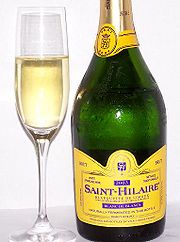
Limoux
Limoux is a commune and subprefecture in the Aude department, a part of the ancient Languedoc province and the present-day Languedoc-Roussillon region in southern France...
. The wines are normally composed of 70% Mauzac and a 30% combination of Chardonnay and Chenin Blanc. AOC regulations require a year of aging on the lees
Lees (fermentation)
Lees refers to deposits of dead yeast or residual yeast and other particles that precipitate, or are carried by the action of "fining", to the bottom of a vat of wine after fermentation and ageing. The yeast deposits in beer brewing are known as trub...
. The Blanquette de Limoux, when labelled méthode ancestrale, is composed entirely of Mauzac, undergoes only one fermentation and is aged approximately three months less on the lees before the bottling, the actual date being determined by the moon's cycle.

